Water Retention Performance at Low-Impact Development (LID) Field Sites in Taipei, Taiwan
Abstract
1. Introduction
2. Methodology
2.1. Description of the Field Sites
2.2. Monitoring Plan
2.2.1. FuHsin Site
2.2.2. Taipei Tech Site
2.2.3. BeiTou Site
2.3. The SWMM and the Model Validation Process
3. Results and Discussion
3.1. Verification of the SWMM
3.2. Observation and Simulation Results for the 3 Sites
3.3. Performance Simulation with the Design Storm Standard
3.4. Factors Affecting the Water Conservation Capability of LIDs
4. Conclusions
Author Contributions
Funding
Data Availability Statement
Acknowledgments
Conflicts of Interest
References
- Booth, D.B.; Leavitt, J. Field Evaluation of Permeable Pavement Systems for Improved Stormwater Management. J. Am. Plan. Assoc. 1999, 65, 314–325. [Google Scholar] [CrossRef]
- Morsy, M.M.; Goodall, J.L.; Shatnawi, F.M.; Meadows, M.E. Distributed Stormwater Controls for Flood Mitigation within Urbanized Watersheds: Case Study of Rocky Branch Watershed in Columbia, South Carolina. J. Hydrol. Eng. 2016, 21, 05016025. [Google Scholar] [CrossRef]
- Bae, C.; Lee, D.K. Effects of low-impact development practices for flood events at the catchment scale in a highly developed urban area. Int. J. Disaster Risk Reduct. 2020, 44, 101412. [Google Scholar] [CrossRef]
- Weiss, P.T.; Kayhanian, M.; Gulliver, J.S.; Khazanovich, L. Permeable pavement in northern North American urban areas: Research review and knowledge gaps. Int. J. Pavement Eng. 2019, 20, 143–162. [Google Scholar] [CrossRef]
- Li, J.; Deng, C.; Li, Y.; Li, Y.; Song, J. Comprehensive Benefit Evaluation System for Low-Impact Development of Urban Stormwater Management Measures. Water Resour. Manag. 2017, 31, 4745–4758. [Google Scholar] [CrossRef]
- Fiori, A.; Volpi, E. On the Effectiveness of LID Infrastructures for the Attenuation of Urban Flooding at the Catchment Scale. Water Resour. Res. 2020, 56. [Google Scholar] [CrossRef]
- Lin, J.-Y.; Chen, C.-F.; Ho, C.-C. Evaluating the effectiveness of green roads for runoff control. J. Sustain. Water Built Environ. 2018, 4, 04018001. [Google Scholar] [CrossRef]
- Chen, C.-F.; Lin, J.-Y.; Ho, C.-C.; Kuo, C.-T. Performance Evaluation of Combined LID Facilities on Runoff Reduction—A Case of Taipei Tech Campus in Taiwan. In Proceedings of the International Low Impact Development Conference 2018, Nashville, Tennessee, 12–15 August 2018; pp. 223–229. [Google Scholar]
- Cheng, Y.-Y.; Lo, S.-L.; Ho, C.-C.; Lin, J.-Y.; Yu, S. Field Testing of Porous Pavement Performance on Runoff and Temperature Control in Taipei City. Water 2019, 11, 2635. [Google Scholar] [CrossRef]
- Brattebo, B.O.; Booth, D.B. Long-term stormwater quantity and quality performance of permeable pavement systems. Water Res. 2003, 37, 4369–4376. [Google Scholar] [CrossRef]
- Abbott, C.L.; Comino-Mateos, L. In-situ hydraulic performance of a permeable pavement sustainable urban drainage system. Water Environ. J. 2003, 17, 187–190. [Google Scholar] [CrossRef]
- Vaillancourt, C.; Duchesne, S.; Pelletier, G. Hydrologic Performance of Permeable Pavement as an Adaptive Measure in Urban Areas: Case Studies near Montreal, Canada. J. Hydrol. Eng. ASCE 2019, 24. [Google Scholar] [CrossRef]
- Gulbaz, S.; Kazezyilmaz-Alhan, C.M. Experimental investigation on hydrologic performance of LID with rainfall-watershed-bioretention system. J. Hydrol. Eng. 2016, 22, D4016003. [Google Scholar] [CrossRef]
- Jia, H.; Wang, X.; Ti, C.; Zhai, Y.; Field, R.; Tafuri, A.N.; Cai, H.; Yu, S.L. Field monitoring of a LID-BMP treatment train system in China. Environ. Monit. Assess. 2015, 187, 373. [Google Scholar] [CrossRef] [PubMed]
- Mai, Y.; Zhang, M.; Chen, W.; Chen, X.; Huang, G.; Li, D. Experimental study on the effects of LID measures on the control of rainfall runoff. Urban Water J. 2018, 15, 827–836. [Google Scholar] [CrossRef]
- Ahiablame, L.M.; Engel, B.A.; Chaubey, I. Effectiveness of low impact development practices in two urbanized watersheds; Retrofitting with rain barrel/cistern and porous pavement. J. Environ. Manag. 2013, 119, 151–161. [Google Scholar] [CrossRef]
- Lee, J.M.; Hyun, K.H.; Choi, J.S. Analysis of the impact of low impact development on runoff from a new district in Korea. Water Sci. Technol. 2013, 68, 1315–1321. [Google Scholar] [CrossRef]
- Hu, M.; Sayama, T.; Zhang, X.; Tanaka, K.; Takara, K.; Yang, H. Evaluation of low impact development approach for mitigating flood inundation at a watershed scale in China. J. Environ. Manag. 2017, 193, 430–438. [Google Scholar] [CrossRef]
- Bai, Y.; Li, Y.; Zhang, R.; Zhao, N.; Zeng, X. Comprehensive performance evaluation system based on environmental and economic benefits for optimal allocation of LID facilities. Water 2019, 11, 341. [Google Scholar] [CrossRef]
- Li, Q.; Wang, F.; Yu, Y.; Huang, Z.; Li, M.; Guan, Y. Comprehensive performance evaluation of LID practices for the sponge city construction: A case study in Guangxi, China. J. Environ. Manag. 2019, 231, 10–20. [Google Scholar] [CrossRef]
- Vogel, J.; Moore, T. Urban stormwater characterization, control, and treatment. Water Environ. Res. 2016, 88, 1918–1950. [Google Scholar] [CrossRef]
- Luan, Q.; Fu, X.; Song, C.; Wang, H.; Liu, J.; Wang, Y. Runoff effect evaluation of LID through SWMM in typical mountainous, low-lying urban areas: A case study in China. Water 2017, 9, 439. [Google Scholar] [CrossRef]
- Rossman, L.A. Storm Water Management Model User’s Manual Version 5.1; U.S. Environmental Protection Agency: Cincinnati, OH, USA, 2015. [Google Scholar]
- Ahiablame, L.; Shakya, R. Modeling flood reduction effects of low impact development at a watershed scale. J. Environ. Manag. 2016, 171, 81–91. [Google Scholar] [CrossRef] [PubMed]
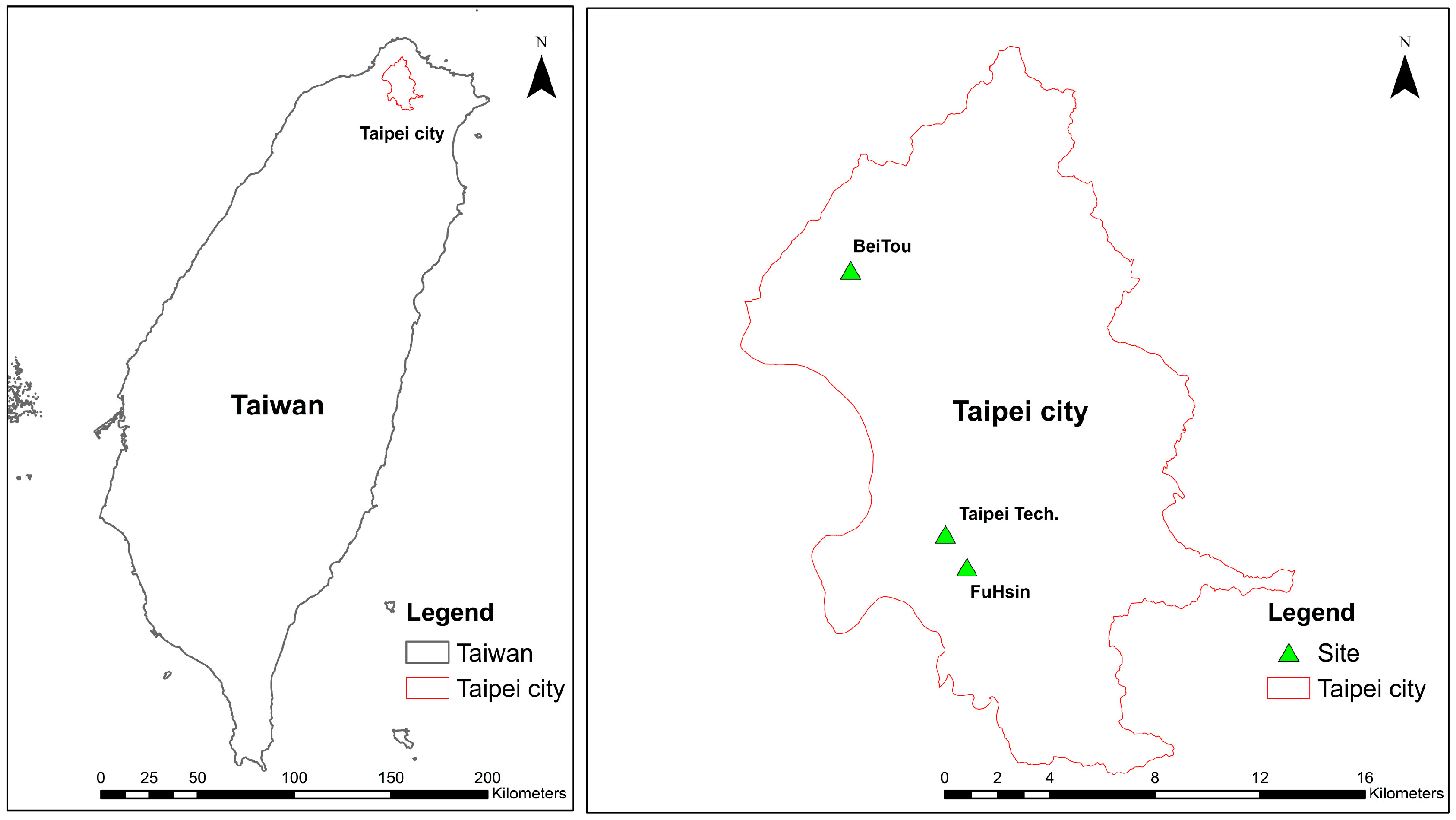
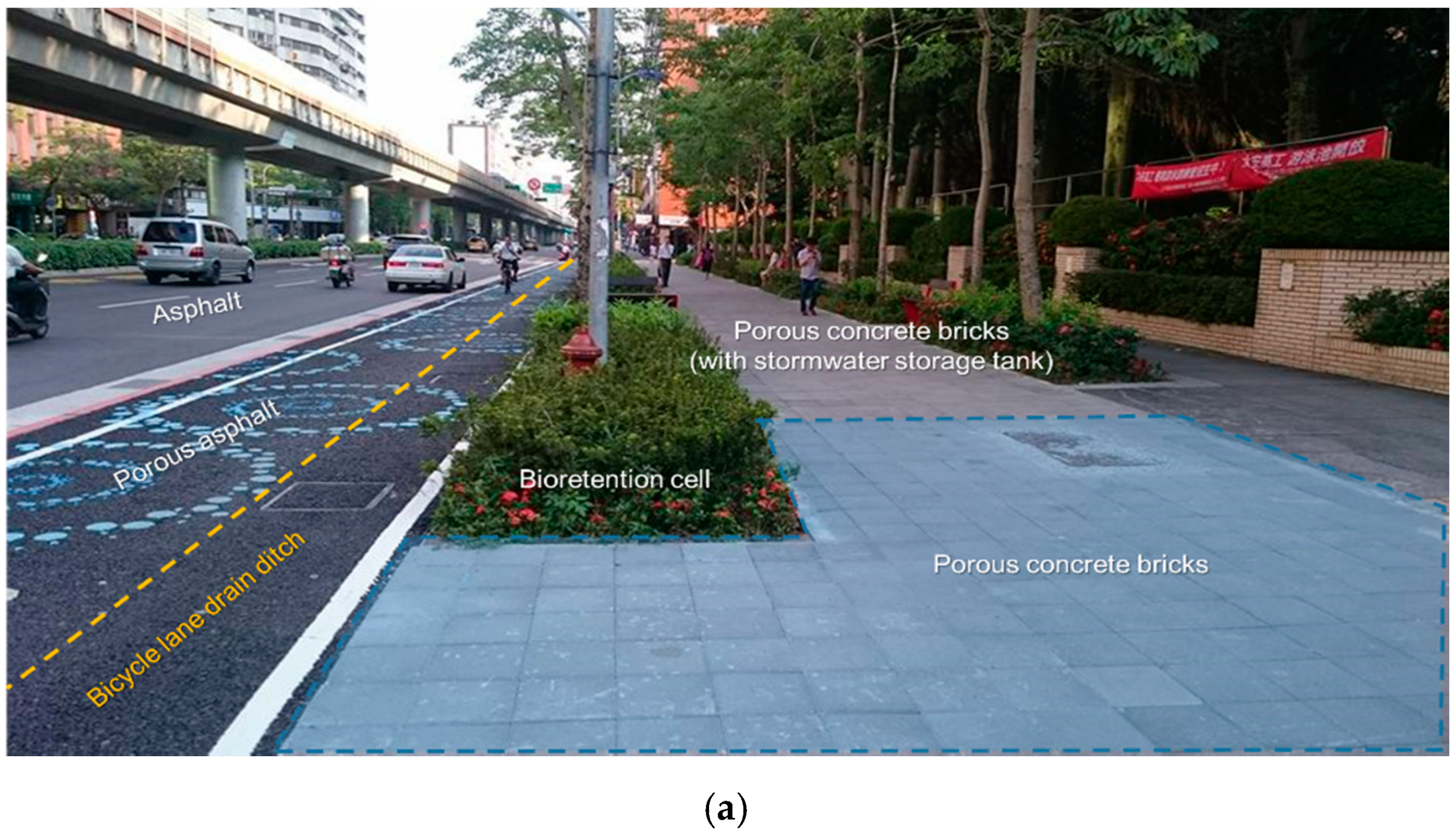
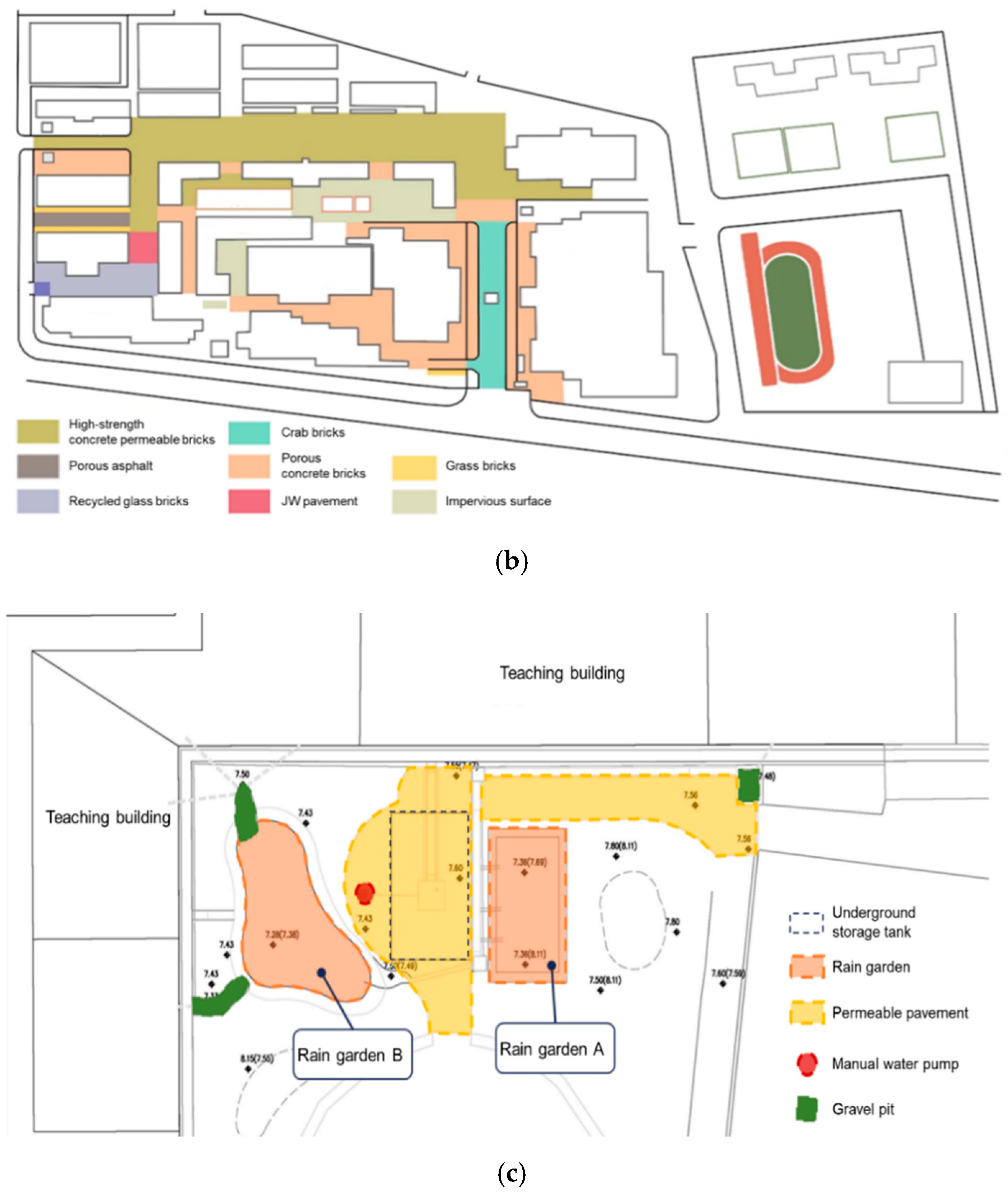
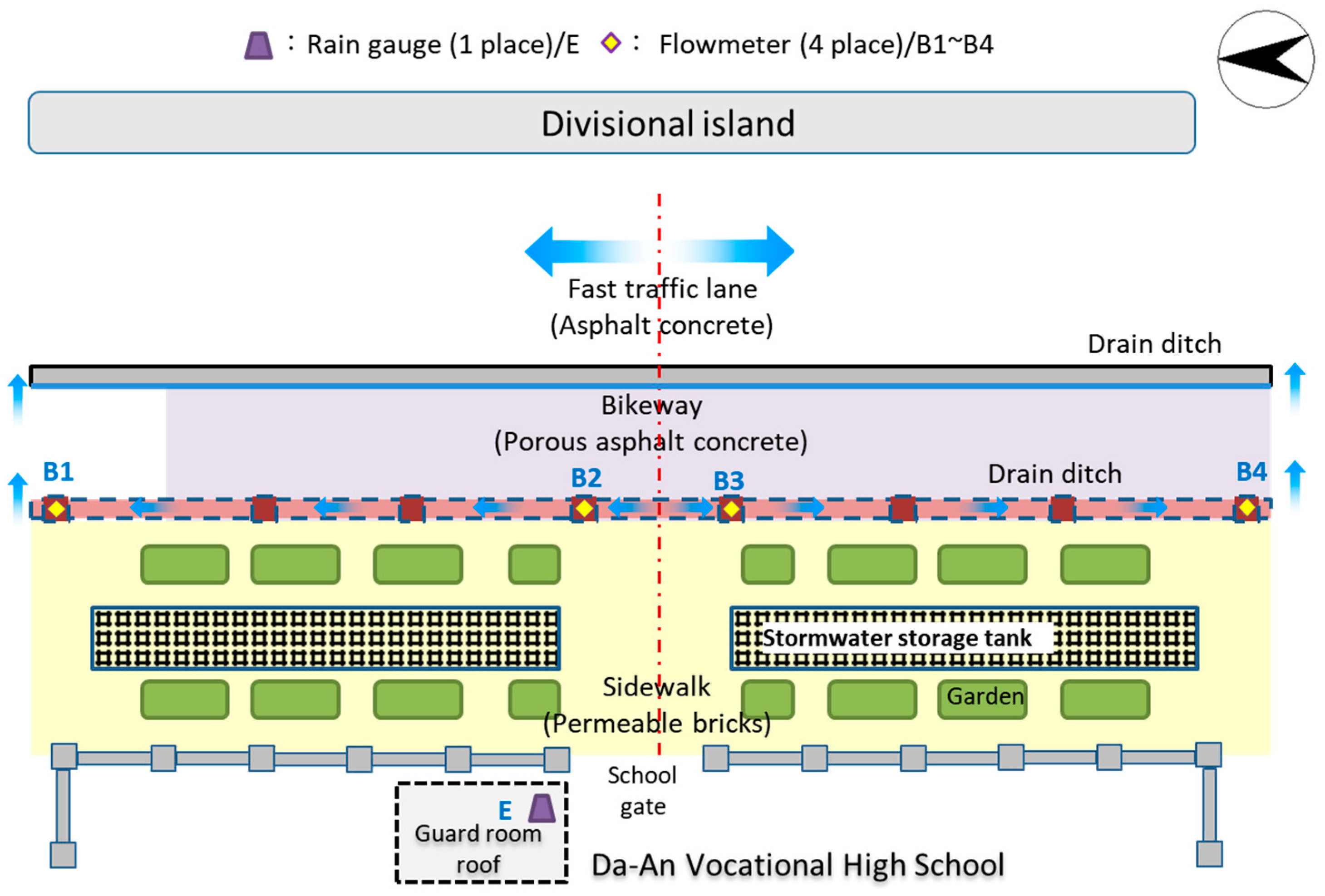
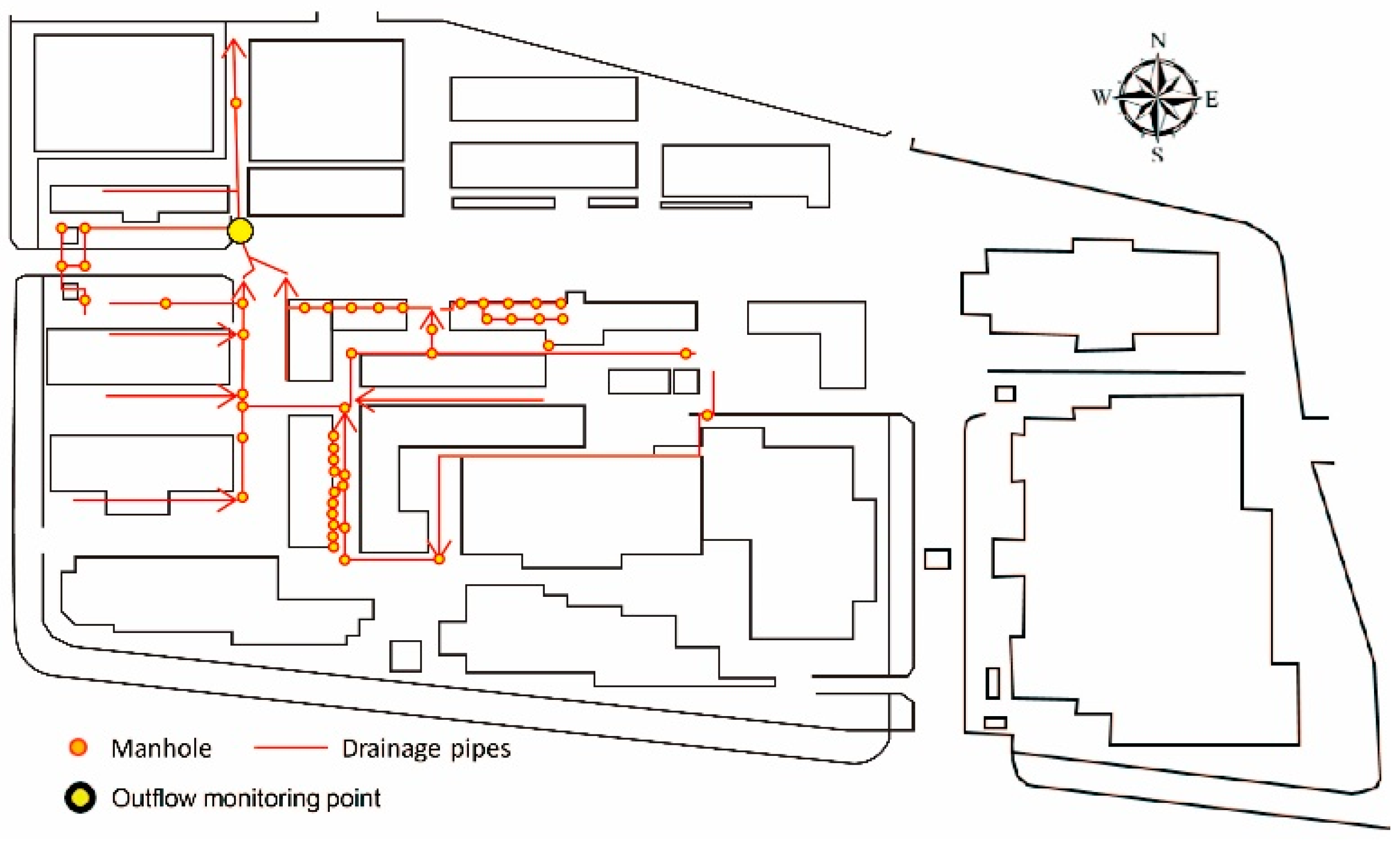
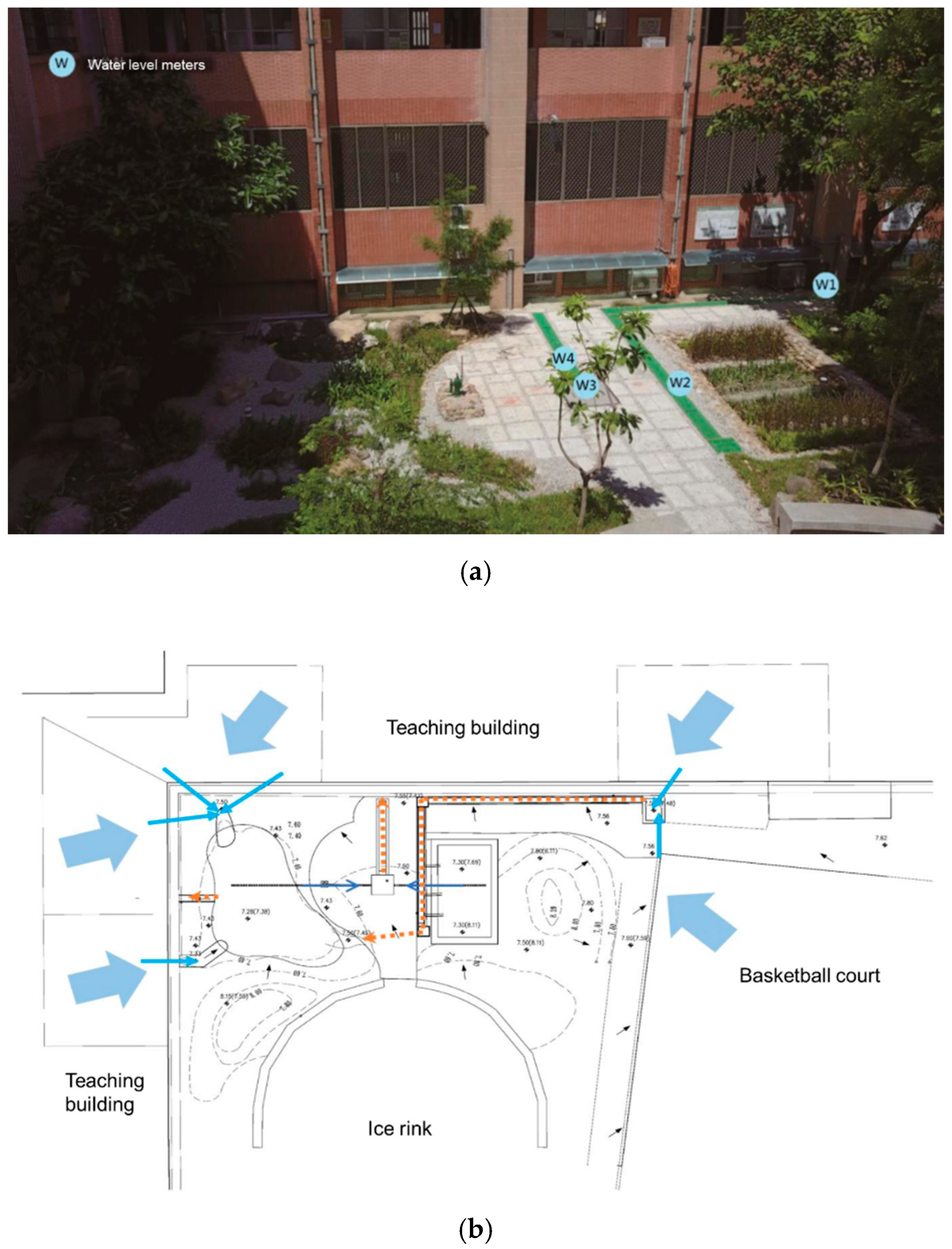
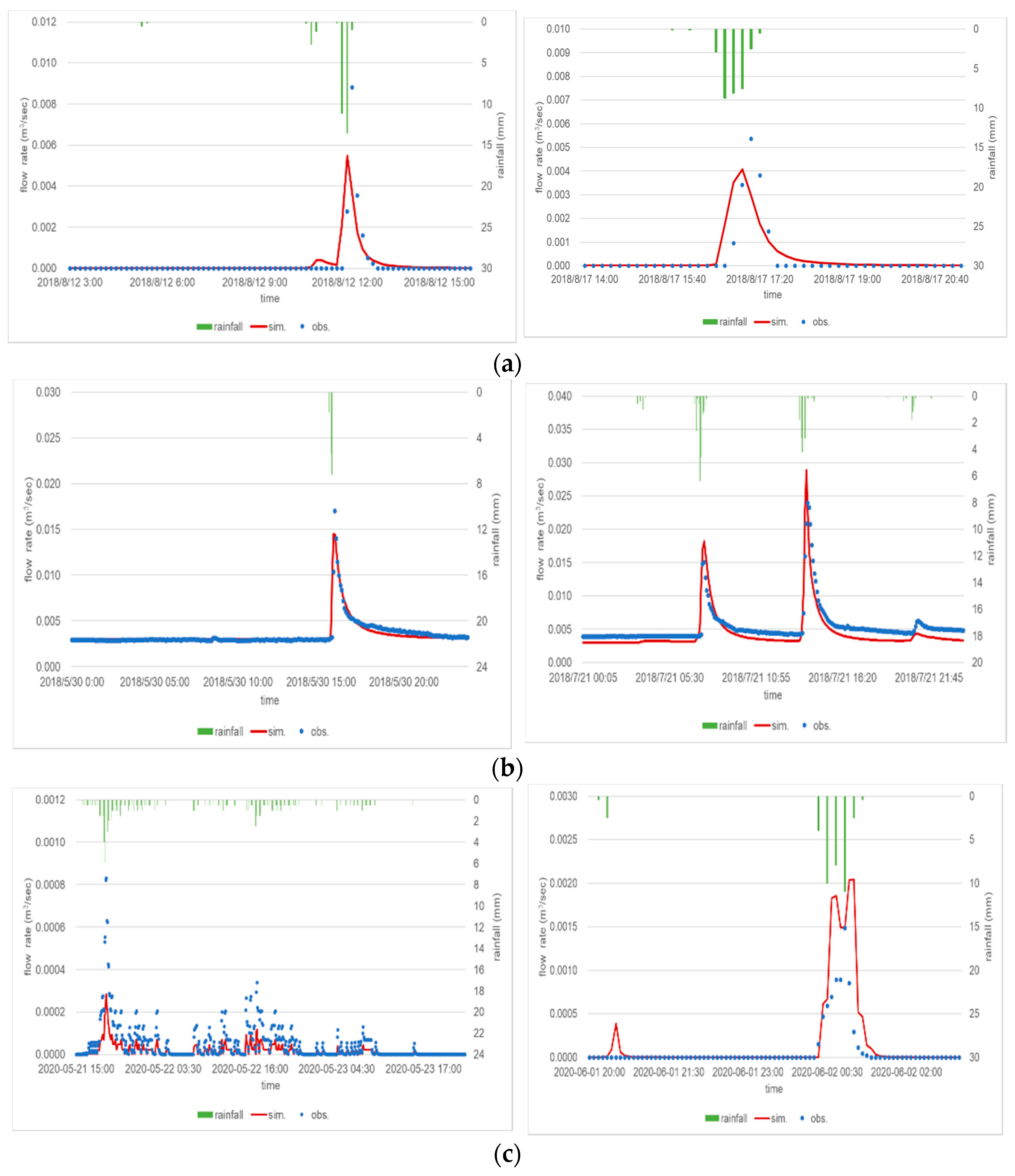

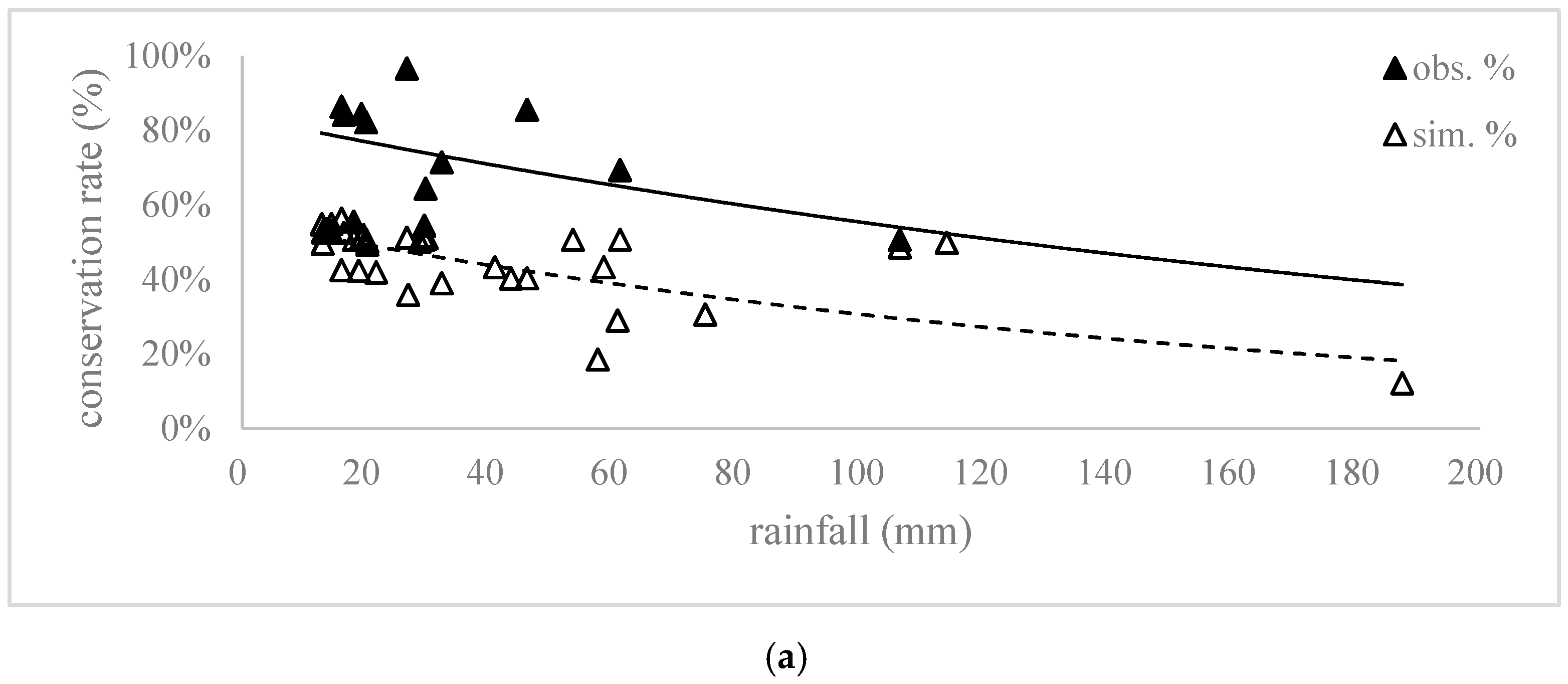
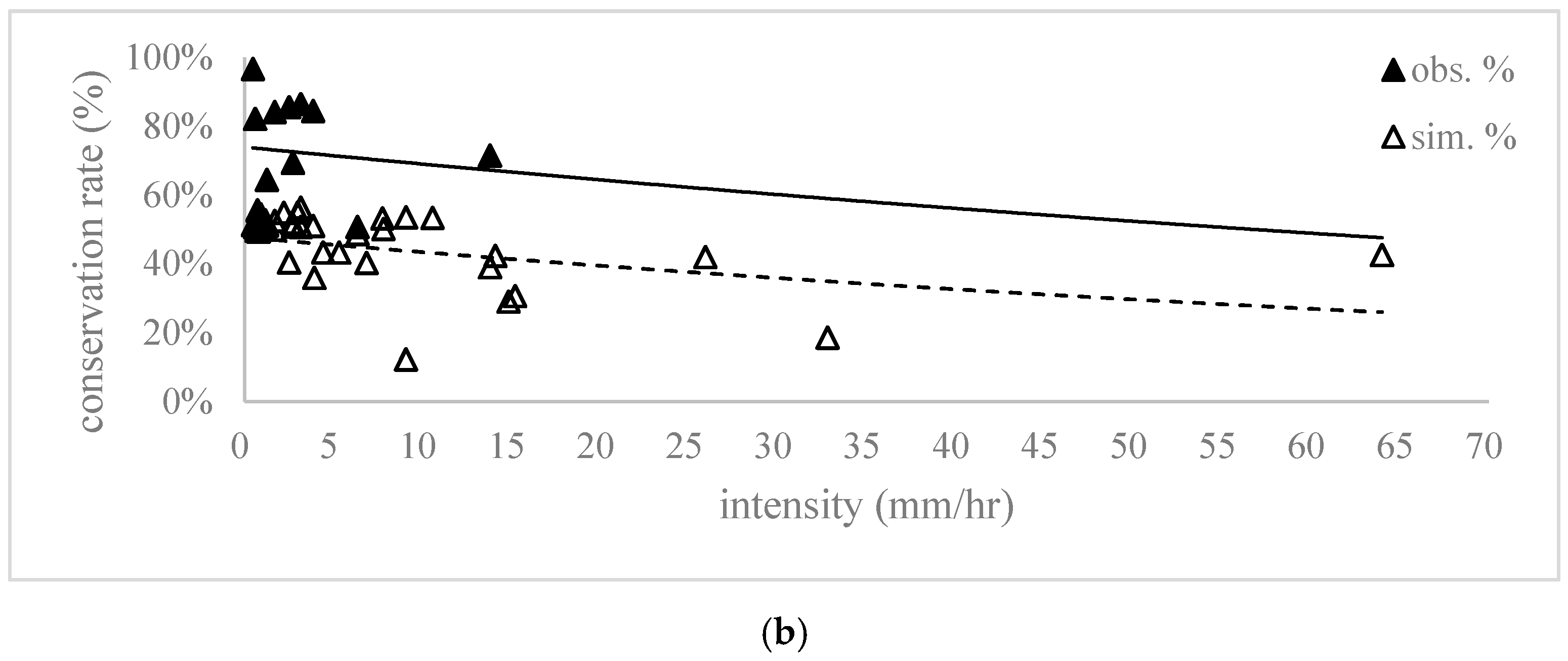
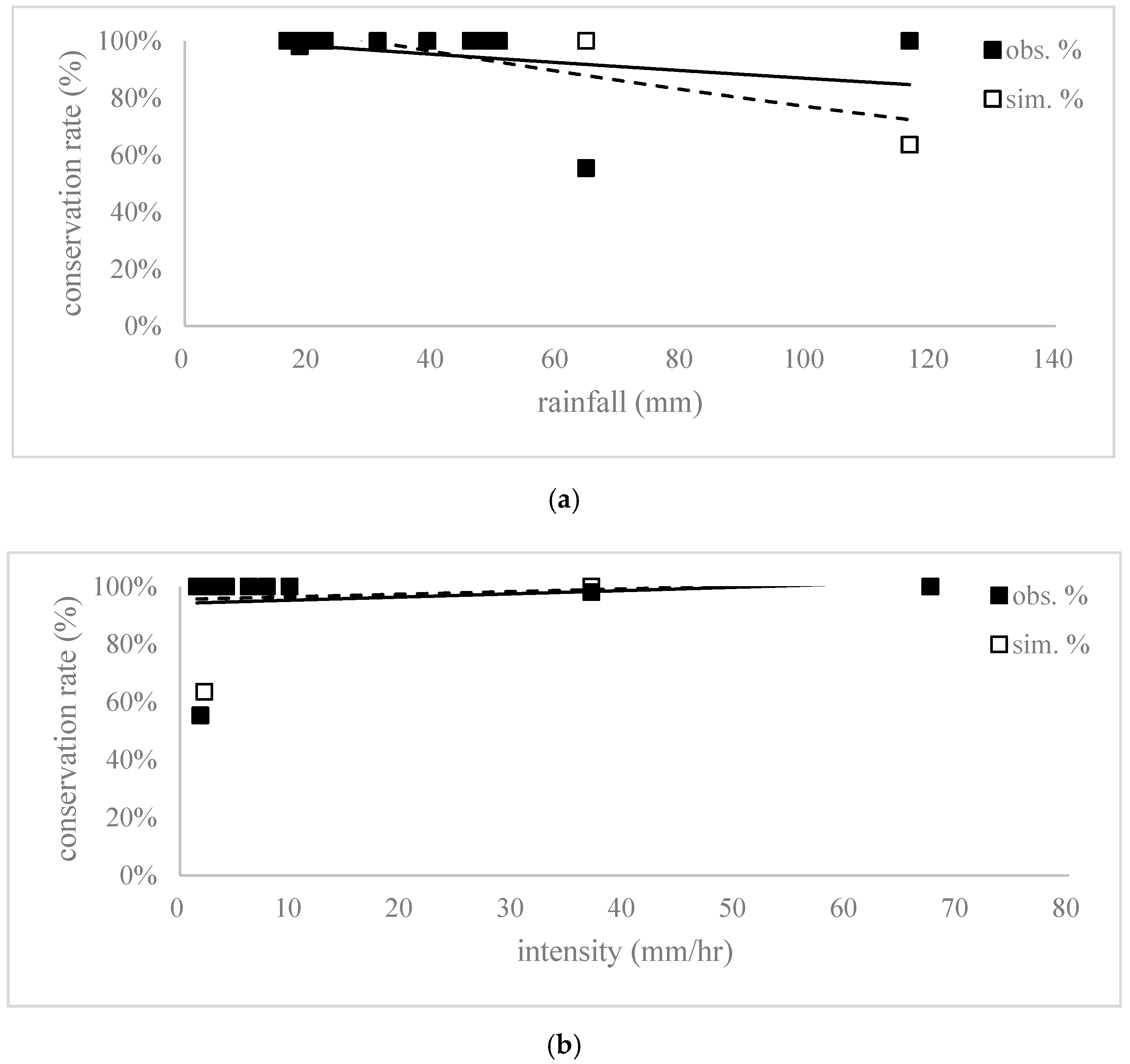
| Date | Total Rainfall (mm) | Rainfall Duration (h:min) | Average Rainfall Intensity (mm/h) |
|---|---|---|---|
| 12/4/2018 | 35.5 | 1:10 | 30.43 |
| 16–17/4/2018 | 17.8 | 8:40 | 2.05 |
| 8/5/2018 | 26.6 | 4:00 | 6.65 |
| 30/5/2018 | 18.2 | 00:30 | 36.40 |
| 10–11/7/2018 | 126.8 | 16:10 | 7.84 |
| 21/7/2018 | 26.6 | 7:20 | 3.63 |
| 24/7/2018 | 27.8 | 2:00 | 13.90 |
| 11/8/2018 | 30.2 | 7:50 | 3.86 |
| 12/8/2018 | 45.8 | 6:50 | 6.70 |
| 17/8/2018 | 31.2 | 1:40 | 18.72 |
| 20/8/2018 | 13 | 00:40 | 19.50 |
| 30/8/2018 | 54.4 | 9:20 | 5.83 |
| 1/9/2018 | 22.6 | 1:10 | 19.37 |
| 7/9/2018 | 39.6 | 3:50 | 10.33 |
| 8/9/2018 | 152.0 | 6:00 | 25.33 |
| 9/9/2018 | 18.4 | 17:20 | 1.06 |
| 15–16/9/2018 | 20.4 | 27:30 | 0.74 |
| 25–27/9/2018 | 24.2 | 35:00 | 0.69 |
| 10–11/10/2018 | 16.8 | 13:05 | 1.28 |
| 11–12/10/2018 | 25.8 | 17:45 | 1.45 |
| 16–17/10/2018 | 30.8 | 11:00 | 2.80 |
| 1–2/11/2018 | 21.8 | 42:10 | 0.52 |
| 23–24/12/2018 | 41.2 | 30:40 | 1.34 |
| 16–17/1/2019 | 21.1 | 25:00 | 0.85 |
| 23–24/2/2019 | 57.4 | 22:40 | 2.53 |
| 6–10/3/2019 | 89.4 | 84:20 | 1.06 |
| 25/3/2019 | 15 | 6:10 | 2.43 |
| 29–30/3/2019 | 24 | 5:20 | 4.50 |
| 11/4/2019 | 15.6 | 8:30 | 1.84 |
| 15–16/4/2019 | 29 | 24:00 | 1.21 |
| 20–21/4/2019 | 40.6 | 10:40 | 3.81 |
| 22/4/2019 | 23.8 | 5:00 | 4.76 |
| 1/5/2019 | 46.6 | 17:10 | 2.71 |
| 2–3/5/2019 | 14.4 | 20:30 | 0.70 |
| 6–7/5/2019 | 24.2 | 27:10 | 0.89 |
| 9–10/5/2019 | 14 | 8:20 | 1.68 |
| 17/5/2019 | 62.4 | 11:40 | 5.35 |
| 20/5/2019 | 57.8 | 05:20 | 10.84 |
| 27/5/2019 | 65.6 | 02:30 | 26.24 |
| 28/5/2019 | 34.2 | 06:40 | 5.13 |
| Date | Total Rainfall (mm) | Rainfall Duration (h:min) | Average Rainfall Intensity (mm/h) |
|---|---|---|---|
| 8/5/2018 | 28.6 | 03:40 | 7.8 |
| 29/5/2018 | 14.2 | 01:50 | 7.75 |
| 30/5/2018 | 16 | 00:15 | 64 |
| 6/6/2018 | 13.6 | 01:30 | 9.07 |
| 10/6/2018 | 12.8 | 05:50 | 2.19 |
| 29/6/2018 | 13.2 | 01:15 | 10.56 |
| 30/6/2018 | 18.8 | 01:20 | 14.1 |
| 10–11/7/2018 | 106.2 | 16:45 | 6.34 |
| 21/7/2018 | 46 | 18:30 | 2.49 |
| 24/7/2018 | 21.6 | 00:50 | 25.92 |
| 12/8/2018 | 26.8 | 06:50 | 3.92 |
| 14/8/2018 | 13 | 11:10 | 1.16 |
| 17/8/2018 | 32.2 | 02:20 | 13.8 |
| 7/9/2018 | 60.6 | 04:05 | 14.84 |
| 8–9/9/2018 | 187.4 | 20:40 | 9.07 |
| 10/9/2018 | 16.4 | 09:45 | 1.68 |
| 25–27/9/2018 | 20 | 34:30 | 0.58 |
| 10–11/10/2018 | 20.2 | 25:40 | 0.79 |
| 11–12/10/2018 | 29.4 | 32:40 | 0.90 |
| 16–17/10/2018 | 29.6 | 23:50 | 1.24 |
| 26–28/10/2018 | 26.6 | 57:40 | 0.46 |
| 16–17/1/2019 | 18 | 25:15 | 0.71 |
| 23–24/2/2019 | 61 | 22:35 | 2.70 |
| 6–10/3/2019 | 113.8 | 96:15 | 1.18 |
| 25/3/2019 | 19.6 | 07:20 | 2.67 |
| 29–30/3/2019 | 19.2 | 05:00 | 3.84 |
| 11/4/2019 | 16 | 05:05 | 3.15 |
| 15–16/4/2019 | 29.8 | 24:05 | 1.24 |
| 20–21/4/2019 | 40.8 | 9:15 | 4.41 |
| 22/4/2019 | 14.4 | 4:50 | 2.98 |
| 01/5/2019 | 53.4 | 17:00 | 3.14 |
| 6–7/5/2019 | 20.2 | 24:30 | 0.82 |
| 9–10/5/2019 | 13 | 20:00 | 0.65 |
| 17/5/2019 | 58.4 | 11:00 | 5.31 |
| 20/5/2019 | 74.8 | 4:55 | 15.21 |
| 27/5/2019 | 57.4 | 1:45 | 32.80 |
| 28/5/2019 | 43.4 | 6:20 | 6.85 |
| Date | Total Rainfall (mm) | Rainfall Duration (h:min) | Average Rainfall Intensity (mm/h) |
|---|---|---|---|
| 27/1/2020 | 31 | 20:20 | 1.52 |
| 16/2/2020 | 16.5 | 4:00 | 4.13 |
| 5/3/2020 | 18 | 10:30 | 1.71 |
| 10/3/2020 | 48.5 | 14:00 | 3.46 |
| 13/3/2020 | 19 | 10:10 | 1.87 |
| 27/3/2020 | 22.5 | 0:20 | 67.50 |
| 28/3/2020 | 20 | 6:50 | 2.93 |
| 23/5/2020 | 116.5 | 53:40 | 2.17 |
| 28/5/2020 | 64.5 | 35:20 | 1.83 |
| 2/6/2020 | 39 | 5:00 | 7.80 |
| 7/6/2020 | 50.5 | 8:10 | 6.18 |
| 14/6/2020 | 46 | 4:40 | 9.86 |
| 1/7/2020 | 0:30 | 18.5 | 37.00 |
| Rainfall (mm) | Intensity (mm/h) | |||||
|---|---|---|---|---|---|---|
| Level | 20 | 60 | 150 | 5 | 20 | 50 |
| FuHsin | 60% | 53% | 40% | 61% | 45% | 25% |
| Taipei Tech | 76% | 65% | 45% | 71% | 64% | 52% |
| BeiTou | 97% | 90% | 75% | 96% | - | - |
| Site | Water Conservation Rate (%) |
|---|---|
| FuHsin | 9.1 |
| Taipei Tech | 14.2 |
| BeiTou | 61.0 |
Publisher’s Note: MDPI stays neutral with regard to jurisdictional claims in published maps and institutional affiliations. |
© 2021 by the authors. Licensee MDPI, Basel, Switzerland. This article is an open access article distributed under the terms and conditions of the Creative Commons Attribution (CC BY) license (http://creativecommons.org/licenses/by/4.0/).
Share and Cite
Lin, J.-Y.; Yuan, T.-C.; Chen, C.-F. Water Retention Performance at Low-Impact Development (LID) Field Sites in Taipei, Taiwan. Sustainability 2021, 13, 759. https://doi.org/10.3390/su13020759
Lin J-Y, Yuan T-C, Chen C-F. Water Retention Performance at Low-Impact Development (LID) Field Sites in Taipei, Taiwan. Sustainability. 2021; 13(2):759. https://doi.org/10.3390/su13020759
Chicago/Turabian StyleLin, Jen-Yang, Ti-Chi Yuan, and Chi-Feng Chen. 2021. "Water Retention Performance at Low-Impact Development (LID) Field Sites in Taipei, Taiwan" Sustainability 13, no. 2: 759. https://doi.org/10.3390/su13020759
APA StyleLin, J.-Y., Yuan, T.-C., & Chen, C.-F. (2021). Water Retention Performance at Low-Impact Development (LID) Field Sites in Taipei, Taiwan. Sustainability, 13(2), 759. https://doi.org/10.3390/su13020759







